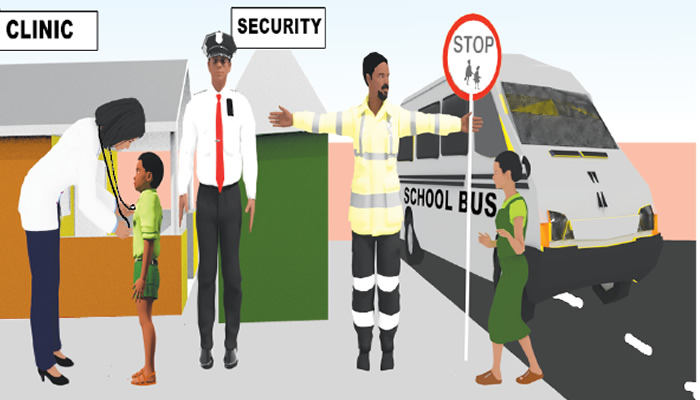
Slips, falls and trips are common accidents in schools. This is mostly caused by carelessness, clumsiness, tiredness, miscalculation of risk, nervousness and negligence of both children and caregivers in school.
Studies identify sports, physical education and school play accidents as common activities where children can sustain injuries.
Recent data further affirms that over 55 per cent of injuries happen during these events.
Sadly, there is a seeming rise in the level of avoidable accidents, deaths, bullying, abuse and sexual exploitation in schools.
Last week, a 12-year-old student of a private school was alleged to have died of electrocution during a sporting activity organised by the school. Also, justice was served to a school teacher after he bagged life jail for defiling a six-year-old pupil.
When children are in school, their safety and protection become the responsibility of the school authorities and all members of staff.
Here are seven inexhaustible measures to safeguard children in school.
Ensure the school is childproof
An expert in family protection, social security and safety profiling, Akinkunmi Vaughan-Thomas, says it is important that a school area is paved and arranged to ensure the safety of children on the school premises.
Vaughan-Thomas also says that children need to learn in a safe place without the fear of physical, emotional and mental harm to their person.
He says, “Family protection is the cultivating of a law-abiding child to reign in life through mentoring with developed innate creative potential.”
He adds that childproofing provides students with a safe place to learn, play and explore without the fear of preventable injuries and accidents.
School security
The safety of the school environment is non-negotiable. A school building must have thorough security procedures and systems, which include perimeter fencing, gates and railings to prevent strangers from entering the grounds.
Also, adequate closed-circuit television cameras should be positioned where appropriate and closely monitored by experienced personnel.
According to a professional website, High-Speed Training, a strict policy for child collection is another security measure school administrators must put in place.
It states, “For example, if another family member is coming, use a secret word that only you and the family member know. You must also implement thorough security checks on your computer systems. These should prevent anybody from accessing your systems and confidential information, and stop dangerous people from potentially contacting your students.”
Train staff in safety
Vaughan-Thomas says school administrators and staff should be trained on standards of family protection, safeguarding children and juvenile delinquency studies.
He adds that an all-encompassing adoption and enforcement of training and standard certification in family protection will help teachers gain the requisite knowledge and experience in ensuring the safety of children in schools.
The safety expert says, “It is necessary to appoint (maybe) a senior member of staff from the leadership team to be trained and certified in Professional Family Protection (social security and safety). After the training, the individual is designated with the title of a Family Protection Lead. School management should ensure this person has the time, funding, training, resources and support to perform the role effectively. The family protection lead will need a capable assistant; a trained assistant lead is often reliable, needful and essential in escalating school matters (terror crises) to hold the lead line for the lead.”
More vigilance during outdoor events
Also, an educationist and former principal of King’s College, Lagos State, Dele Olapeju, says there is a need to ensure extra vigilance during outdoor and extracurricular activities.
On this wise, Olapeju says that teachers and other members of staff should be given basic training on how to control children during outdoor activities.
He says, “There must be more vigilance around our schoolchildren and policing of events being held by the school authority. This will help to prevent loopholes that will make persons with ulterior motives take advantage of the children’s innocence.”
The former principal urges teachers and children caregivers to engage in a high level of professionalism in dealings with children in their care.
“Character building is a must-have in our curriculum and the lives of the teachers. Parents must not shy away from sex education for their children,” Olapeju says.
Presence of an emergency kit
Schools need to have an emergency first aid kit with the right equipment and trained first aiders. This is essential for providing immediate care to the injured before transporting them to the hospital if need be.
First aid kits should be within quick and easy reach at all times. During off-site activities such as travel and sporting events, appropriate kits should be available.
Here are some first aid items needed in schools: a life-saving defibrillator, fire safety supplies, fire blankets, and appropriate fire extinguishers, additional first aid kits, personal protective equipment, posters, emergency signs, health and safety supplies, evacuation chairs for people with mobility impairments.
Zero tolerance for bullying
Vaughan-Thomas emphasises the importance of schools adopting a no-tolerance policy for bullying and other forms of discrimination.
He adds that behavioural displays of “bullying, racism, sexism, verbal and or sexual abuse, homophobic behaviour or any other form of discrimination” should not be tolerated among children.
Teach students about safety
Children must be taught safety measures, who to call, and what to do whenever there is an emergency. When children know this, they will call the attention of an adult whenever the need arises.
The family protection expert adds, “Ensuring the curriculum affords a range of opportunities to learn about keeping themselves safe, particularly when using technology.”
Vaughn-Thomas, who is also an art of crime expert illustrator in deviance and defiance therapy, adds that members of staff attend “advocacy, prevention and protection training in respect of radicalisation and extremist behaviour and by assessing the risk of pupils being drawn into terrorism.”





